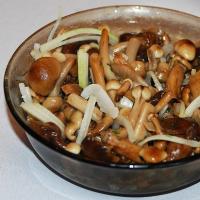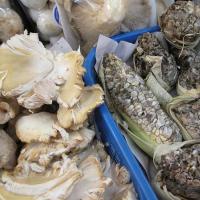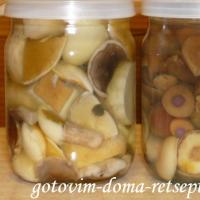Species diversity of mushrooms in Bashkiria
The territory of Bashkiria is characterized by a temperate continental climate with cold and long winters, warm and moderately humid summers. And the presence of the main forest species in the form of birch, linden, pine, aspen, spruce and oak makes it possible to collect a rich harvest of mushrooms almost every year.
The beginning of the mushroom season in Bashkiria
The mushroom season in Bashkiria, as a rule, begins with a period of almost complete melting of the snow mass and lasts until the onset of a fairly strong autumn cold snap. In the presence of heavy precipitation and warm weather in the spring, mushrooms begin to appear much earlier.
The main spring species include the common morel, the string morel, and the cap morel. The most valuable summer varieties are represented by boletus, as well as chanterelles, boletus and boletus. With the onset of the autumn period, mass fruiting of saffron milk caps, butter mushrooms, honey mushrooms, and also real milk mushrooms begins.
What mushrooms grow in Bashkiria (video)
Edible mushrooms of Bashkiria
The main edible species on the territory of the republic are presented in a wide variety, differ in nutritional value and belong to different categories.
Common morel
It has an uneven, spherical, hollow and cellular cap of brownish color, as well as a hollow stem. Grows in mixed and deciduous forest zones, as well as on forest edges and along roads.
It is characterized by the presence of a conical cap of olive-brown, grayish or brown color and a white, fragile, hollow inside stem. The species is widespread in forest areas, as well as in clearings.

Morel cap
It has a bell-shaped cap of yellowish or brown color with a characteristic wrinkled surface. The stem of the variety is quite thin and tall, white or slightly cream in color. Most often it grows under birch, linden and aspen.
Polypore grayish-yellow
It has a very noticeable round-shaped cap, whose appearance resembles a slightly yellowish dough. The hollow stem is soft or relatively hard, depending on the age of the fruiting body. Grows on the surface of a deciduous tree.
White mushroom and oak mushroom
It is characterized by a light brownish cap and a fairly dense stalk of pale, slightly yellowish color. Fruiting bodies are found mainly under oak trees. Dubovik is distinguished by lemon-yellowish, quickly turning blue flesh when cut.

Mosswort
It has a convex cap with a surface resembling suede, greenish-brown in color with an olive tint. The leg, as a rule, is curved, yellowish in color, tapering towards the base. Grows in mixed forest zones.
They are characterized by yellow caps of a convex, flat or funnel-shaped shape, with a dense, cylindrical stem. The fruiting bodies are represented by whitish-yellowish, fairly dense pulp. They bear fruit in mixed forest zones, represented by spruce and birch trees.

Volnushka
It is distinguished by a flat or funnel-shaped cap of bright pinkish color. The stem of this species is thick and quite dense, exuding milky juice when cut. The variety bears fruit in birch groves, as well as mixed forests with a large number of birch trees.
Mokruha spotted
The difference between this edible variety is the reddish-brown or reddish coloring of the lamellar cap and the presence of a medium-sized stalk of the same color. Found in deciduous forests and mixed plantings.
How to pick mushrooms (video)
Inedible and poisonous mushrooms of Bashkiria
A description of the main inedible and poisonous mushrooms growing on the territory of Bashkiria allows us to minimize the risk of poisoning. If inedible mushrooms have a bad taste and most often are not capable of causing harm to human health, then poisonous species are distinguished by the presence of toxins in the mushroom pulp, which can not only cause severe poisoning, but also cause death.
Deadly poisonous species, the toxin of which causes severe poisoning and death. The main distinguishing feature is the presence of a very characteristic pouch at the very base of the leg. The species is found almost everywhere, but most often the pale grebe can be found in mixed forest areas. You can also independently distinguish the poisonous pale grebe from similar edible varieties by the presence of a very peculiar blanket located around the leg. As the fruiting body grows, this covering breaks.

fly agaric
Red fly agarics belong to the category of the most common and almost universally found poisonous species. This species prefers mixed and birch forests, where it can grow in fairly large groups. Despite the fact that deaths from red fly agaric poisoning are quite rare, Eating such fruiting bodies can cause serious health problems.
A deadly poisonous species that grows in groups in deciduous forests, oak groves and coniferous plantings on calcareous soils from August to October. The cap is initially convex and then flat, spread out, with curled edges, dirty white, light silver-gray or brownish-gray with a bluish tint. The pulp is whitish, with a floury taste and smell. The leg is dense, white, mealy, slightly brownish at the bottom.

False honeysuckle sulfur-yellow
A poisonous species that grows most often on stumps, on the soil near stumps, as well as on rotting deciduous and coniferous wood in large groups. The cap, depending on the age of the fruiting body, may have a bell-shaped, prostrate shape and a yellowish or yellowish-brown, as well as sulfur-yellow color. The central part is darker or has a reddish-brown tint. The pulp is light yellow or whitish in color, very bitter, with a characteristic unpleasant odor. The plates are frequent and thin, growing to the stem, sulfur-yellow or greenish, sometimes blackish-olive in color. The leg is long, smooth, hollow, fibrous, light yellow in color.
Mountain gossamer
A variety that is externally similar to many edible species. It is characteristically distinguished by a small and convex cap of brownish color with a dry and distinctly velvety surface. The medium-long leg has a cylindrical shape and is light yellow in color. The main difference is the presence of a sharp radish odor in the pulp.
The most poisonous mushrooms (video)
Mushroom places in Bashkiria
Almost the entire territory of Bashkiria abounds in a large number of edible mushrooms. Experienced mushroom pickers and simply lovers of “quiet hunting” prefer to collect in places remote from highways and large urban settlements. For example, an abundance of champignons is found in the vicinity of the village of Krasny Yar, Ufa district, and for milk mushrooms it is best to go to the Kushnarenkovsky district.
Connoisseurs of saffron milk caps are recommended to go for mushrooms from the vicinity of the village of Ishkarovo, Ilishevsky district, and the forest around the village of Kamyshly. The largest harvest of boletus and porcini mushrooms, as well as honey mushrooms and chanterelles, can be collected in the vicinity of the village of Yazykovo and in the area of the Flour Mill.
Gallery: mushrooms of Bashkiria (39 photos)


























